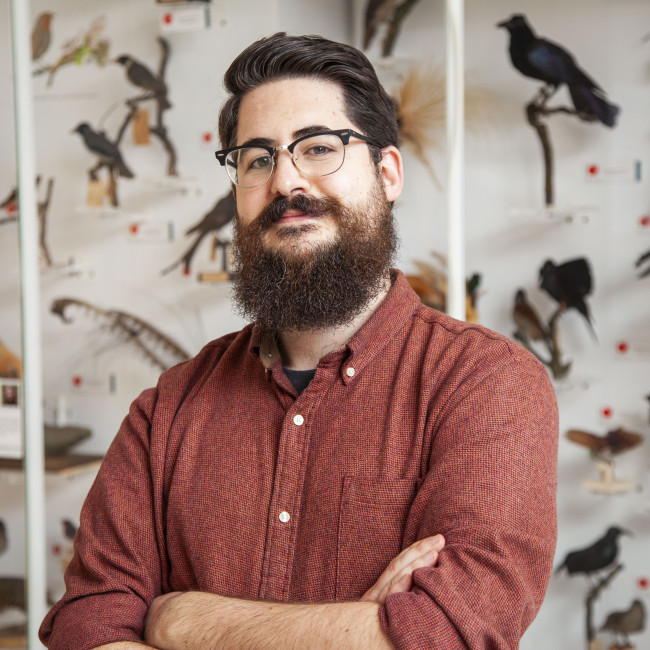Juan is a Henslow Fellow based at the Department of Earth Sciences. Juan is interested in the evolutionary relationships between extant and fossil organisms and how ecological factors - including large-scale geological events such as mass extinctions - affected morphological evolution in deep time. His research-to-date focuses on reconstructing the origins of the anatomically modern bird body plan combining insights from living bird diversity together with key fossils from the earliest representatives of the extant bird lineage. Juan uses a combination of traditional and cutting-edge techniques, such as comparative anatomy, phylogenetic inference and high-resolution three-dimensional computed tomography to reconstruct morphological and ecological adaptations across the evolutionary history of modern birds, from their origins at the end of the Cretaceous period, through the mass extinction that decimated non-avian dinosaurs and the following explosive radiation into the ~11,000 living bird species inhabiting our planet today. Juan has a keen interest in scientific outreach and has published Birds of the Mesozoic, a field-guide style book with the aim of bringing the latest discoveries on bird origins and evolutions to a wider audience.
Juan obtained a Bachelor’s Degree in Biology at the University of Barcelona, and a Master’s Degree in Palaeontology at the Autonomous University of Barcelona. He then moved to the UK to work as a Research Assistant at the University of Birmingham, before pursuing a PhD at the University of Bath, focused on reconstructing the morphological transition separating modern-type birds from their closest extinct relatives. Juan is currently a UKRI-funded Postdoctoral Research Associate at the Department of Earth Sciences, and a Junior Research Fellow at Lucy Cavendish College.
Publications
Books
J. Benito and R. Olive (2022). Birds of the Mesozoic: An Illustrated Field Guide. Lynx Edicions, Barcelona. Illustrated field guide-style book covering Mesozoic fossil bird diversity. Published by
Lynx Edicions, publishers of the highly acclaimed “Handbook of the Birds of the World”.
Peer-Reviewed publications
Butler, R.J., Meade, L.E., Cleary, T.J., McWhirter, K.T., Brown, E.E., Kemp, T.S., Benito, J. and Fraser, N.C. (2023). Hwiccewyrm trispiculum gen. et sp. nov., a new leptopleuronine procolophonid from the Late Triassic of southwest England. The Anatomical Record, 1–31.
T. M. Lowi-Merri, O. E. Demuth, J. Benito, D. J. Field, R. B. J. Benson, S. Claramunt, D.C. Evans (2023). Reconstructing locomotor ecology of extinct avialans: a case study of Ichthyornis comparing sternum morphology and skeletal proportions. Proceedings of the Royal Society B, 290:20222020.
J. Benito, A. Chen, B.A-S. Bhullar, D. Burnham, L. Wilson and D. J. Field (2022). 40 new specimens of Ichthyornis provide unprecedented insight into the postcranial morphology of crownward stem group birds. PeerJ, 10:e13919.
J. Benito, P-C. Kuo, K. E. Widrig, J. W. M. Jagt and D. J. Field (2022). Cretaceous ornithurine supports a neognathous crown bird ancestor. Nature, 612, 100–105
O. E. Demuth, J. Benito, E. Tschopp, S. Lautenschlager, H. Mallison, N. Heeb and D. J. Field (2022). Topology-based three-dimensional reconstruction of delicate fossil remains and the quantification of taphonomic deformation. Frontiers in Ecology and Evolution, 10:828006.
D. J. Field, J. Benito, A. Chen, J. W. M. Jagt and D. T. Ksepka (2020). Late Cretaceous neornithine from Europe illuminates crown bird origins. Nature, 579, 397-401.
R. A. Close, R. B. J. Benson, J. Alroy, A. K. Behrensmeyer, J. Benito, M. T. Carrano, T. J. Cleary, E. M. Dunne, P. D. Mannion, M. D. Uhen and R. J. Butler. Diversity dynamics of Phanerozoic terrestrial tetrapods at the local-community scale. Nature Ecology & Evolution, 3(4), 590-597.
Preprints
Crane, A., Benito, J., Chen, A., Musser, G., Torres, C.R., Clarke, J.A., Lautenschlager, S., Ksepka, D.T. and Field, D.J. (2023). Taphonomic damage obfuscates interpretation of the retroarticular region of the Asteriornis mandible. bioRxiv, 2023.06.13.544555.




